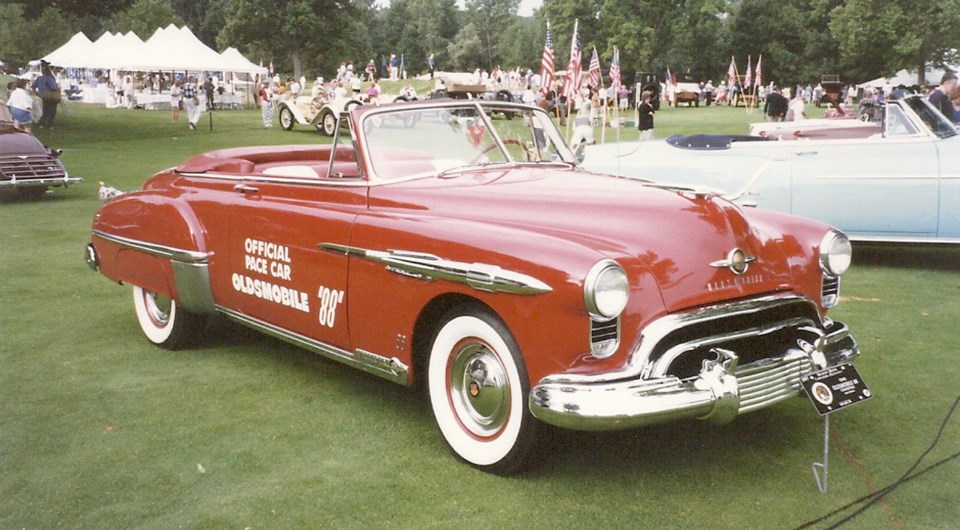The 1949 Oldsmobile ŌĆ£RocketŌĆØ 88 could be called the 1932 Ford of its day. Henry FordŌĆÖs V-8-engine-in-a-light-body creation was one of the most spirited cars of the 1930s. Oldsmobile did the same in the 1950s.
Each was a sensation in its era, although Oldsmobile moved it to a higher plateau and ushered in the modern high-performance era. Both were pioneering efforts. Whereas Ford brought smooth V-8 power to the popular price field, Oldsmobile ŌĆö along with Cadillac ŌĆö introduced the short-stroke, high-compression, overhead-valve V-8 to American cars. It would become the industry staple for more than three decades.
It was not OldsmobileŌĆÖs first V-8. The short-lived Viking ŌĆ£companion carŌĆØ of 1929-1930 had a V-8. It was to be a kind of lower-priced version of CadillacŌĆÖs LaSalle, but the Depression quickly killed it.
Oldsmobile began working on its new V-8, dubbed the ŌĆ£Rocket,ŌĆØ in 1946. Its history traced back to experimental work done by the brilliant Charles Kettering in the 1910s and 1920s.
Kettering, who would become GMŌĆÖs research chief in 1920, and associate Thomas Midgley studied engine-combustion knock caused by pre-ignition of the air-fuel mixture in the combustion chamber. They discovered that adding tetraethyl lead to gasoline raised the fuelŌĆÖs octane, or resistance to knock, allowing higher compression ratios. ŌĆ£EthylŌĆØ gasoline went on sale in 1923.
Following the Second World War, Kettering built an experimental six-cylinder engine with the unheard-of compression ratio of 12.0:1. It gave 35 to 40 per cent better fuel economy and 25 per cent more power than the typical 6.25:1 ratio. When Kettering presented his paper on high compression to the Society of Automotive Engineers in 1947, it ignited a revolution in DetroitŌĆÖs thinking.
KetteringŌĆÖs findings encouraged Oldsmobile to press ahead with a higher-compression engine. They chose a V-8 for its lighter weight, compact design and a crankshaft that was shorter and sturdier than inline eights.
Cadillac was also working on a new overhead-valve, short-stroke, high-compression V-8, which it introduced in 1949, but the Olds and Caddy engines shared no common parts.
The Olds V-8 Rocket engine was introduced in the fall of 1948 in OldsmobileŌĆÖs top-of-the-line 98-series. It displaced 5.0 litres (303.7 cu in.), developed 135┬Āhorsepower and replaced the 4.2-litre (257 cu in.), 115-horsepower inline side-valve eight that dated back to 1932. The series 76 continued with OldsmobileŌĆÖs side-valve six.
In 1949, Olds installed their new V-8 in the lighter 76 series, which shared GMŌĆÖs new A-body with Chevrolet and Pontiac. They called it the 88 and slotted it between the 76 and 98. Introduced as a mid-year model in February 1949, it was chosen as pace car for the 1949 Indy 500.
Enthusiasm ran high for the┬Ānew Olds. Car tester Tom McCahill of Mechanix Illustrated recorded zero to 100 km/h in 13.5┬Āseconds and enthused that ŌĆ£the Oldsmobile Rocket 88 is the fastest U.S. stock car in performance, up to 95 miles an hour [153┬Ākm/h].ŌĆØ
The 88, although a half-year model, helped increase OldsmobileŌĆÖs sales from 171,518 1948 models to 288,310 ŌĆÖ49s. In 1950, Olds sales reached 407,289, of which 268,414 were 88s, convincing Olds to discontinue the six-cylinder 76.
While excelling in the showrooms, the 88 was also cleaning up on the tracks. Almost overnight, the Rocket 88 transformed OldsmobileŌĆÖs image from staid and conservative to stirring and exciting.
It was the one to beat in American Automobile Association and NASCAR events. It won six of the nine NASCAR late-model division races in 1949, 10 of 19 in 1950 and 20 of 41 in 1952. Although it would eventually be eclipsed by HudsonŌĆÖs powerful, low-slung Hornet, for 1952 and ŌĆÖ53 the 88 was the ŌĆ£King of NASCAR.ŌĆØ
For 1951, Olds introduced the Super 88 based on the heavier GM B-body shared with Buick. Although the original 88 continued, the division began concentrating its efforts on the larger model.
By the mid-1950s, everybody was in the V-8 game and the 88 was gradually eclipsed. Chrysler introduced its fabulous Hemi V-8 in 1951, and Ford and other GM divisions got overhead-valve V-8s.
But the Oldsmobile Rocket engine had a powerful and lasting reputation. In the 1970s, about a quarter century after the original Rocket appeared, GM adopted a corporate policy of mixing and matching engines among car lines.
Many Oldsmobile owners were chagrined to find Chevrolet V-8s under their hoods. Even though the Chevy was a later, more sophisticated design, Olds owners were so soundly convinced of the RocketŌĆÖs superiority they took GM to court for misrepresenting its product.
The matter was eventually resolved, but it demonstrated the mystique the Oldsmobile Rocket 88 engine had built.



